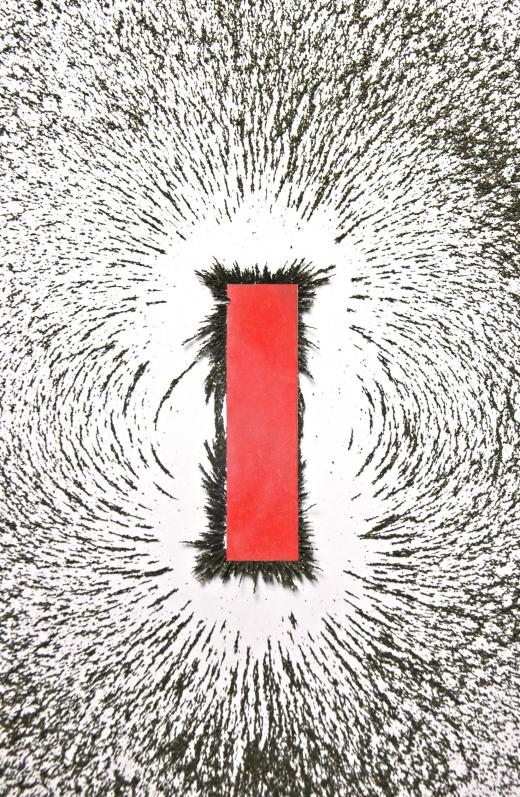How is Magnet Strength Measured?
A magnet is any object that produces its own magnetic field. The magnet strength of these objects can vary from imperceptibly weak fields to incredibly strong fields, depending on a number of characteristics. Magnets can be classed into two distinct groups: permanent magnets and electromagnets, and non-magnets can be defined as either ferromagnetic, paramagnetic, or diamagnetic. Ferromagnetic materials like iron are strongly attracted to magnets, paramagnetic materials like aluminum are only slightly attracted to magnets, and diamagnetic materials like carbon are weakly repelled by magnets.
Permanent magnets are those objects that are magnetized and will stay magnetized forever. One can make a permanent magnet by taking a hard ferromagnetic substance, like hard iron, lodestone, cobalt, and a number of rare earth metals, and magnetizing it strongly. Soft ferromagnetic substances may gain a temporary magnetic field, but will tend to lose it rather quickly. Electromagnets, on the other hand, consist of coils of wire that gain a magnetic field when electricity is run through it, but lose it immediately when the electricity ceases.

You can measure either the overall magnetic strength of a material, known as its magnetic moment, or its local strength, known simply as its magnetization. The magnetic moment can be calculated for a substance depending on whether it contains an inherent magnetism or a magnetism caused by an electric current. If the magnetism is inherent, the magnitude of each elementary particle within the material can be measured and the net moment can be determined. If caused by an electric current, one has to track the magnetism of the electrons flowing through the object.

Magnet strength is generally labeled on commercial magnets as a reading given in terms of its gauss rating, and can be measured with a magnetometer.. There are two main types of magnetometers, one which looks at the net magnetism of an object, known as scalar devices, and another which can track the vectors of magnetism, giving the strength of a magnetic field in a particular direction, known as vector devices. Different magnetometers work in different ways. Common vector magnetometers include superconducting quantum interference devices, atomic SERFs, and fluxgates. Common scalar devices include Hall effect magnetometers, proton precession magnetometers, and rotating coil magnetometers.

It is important to note that often the gauss rating given for a magnet does not actually reflect the surface magnetism of the object. Generally, the magnet strength as calculated on a commercial magnet will reflect the core strength of the magnet, which may be substantially stronger than the surface strength, and will drop off as you get away. For example, a magnet that might measure 3000 Gauss just off the surface of the magnet would measure 2500 Gauss as you went away from the magnet even a slight bit. For this reason, some manufacturers offer alternative measures of magnet strength that help give people a better idea what they’re getting.
In recent years, as rare earth magnets have become popular for home use, magnet strength has begun to simply be given in terms of pull strength, referring to how much weight the magnet can pull, as measured by a Pull-Tester. It should also be noted that magnet strength can be affected by many conditions, including electricity, heat, and in some cases humidity. Magnet strength also drops off exponentially as you get further away from the surface, so a magnet that is very strong right up against it will have no pull when you step away.
AS FEATURED ON:
AS FEATURED ON:













Discussion Comments
You should state the magnetic moment as primary parameters for the magnetic strength of a magnet. There is no measurement position dependency. The magnetic moment does not depend on the material attracted to (as for a permanent magnet in pull test). So the magnetic moment with magnetic axis are the advanced and clear parameters to watch here.
@anon308260: You can't say how strong it would be, as different magnets will be different strengths. The value measured in Gauss will also depend on how far away you are measuring. Arguably, with a fairly decent magnet, it might measure more than 10 kG (kiloGauss) near the surface but less than 100 Gauss as soon as you are two inches away.
How do you explain two magnets of the same size stacked together being only slightly stronger than one alone? Is it just due to the increase in surface area?
How could you do a simple at-home experiment to find the pull force of a magnet that is appx. 1/2"x1/4" cylinder?
If a rare earth magnet rod measures 1 inch in diameter and two meters length, what is the strength of it in gauss, and how is it measured?
How can I find the magnetic strength of a fridge magnet? I attempted to airmail a Christmas package containing cloths, a book, scarves and two fridge magnets to America and I was told I would have to remove the fridge magnets as they are prohibited to be sent by air.
The Post Office online says any item with a magnetic field strength of 0.159A/m or more from a distance of 2.1m from the outside of the package is prohibited. I removed the items and this time the package was accepted (cost £16.52 with and without the magnets). I still have to post the magnets, probably by surface overland mail. --Marian J
Magnets work to provide electrical vibrations in microphones. A thin layer of plastic normally picks up voice waves in the air, vibrating the magnet on the end of a spring, which generates an electrical vibration equal in form and magnitude to the sound wave. This magnifies the voice in a speaker using electromagnetic force. The ancients would call this "magic." As we discover more and more in the universe, I think it will show that these supernatural forces are really quite explainable.
@TrogJoe19
I think all these forces can be shown to be interrelated in terms of the space-time continuum. This is approaching cosmology and going beyond the realm of provable science, but it seems demonstrable from what we have observed that there is a base force from which all these other forces came, and that is why they are interrelated. In cosmology, other dimensions are deduced in terms of the interrelation of forces in string theory, brane theory, and M-theory.
Scientists don't fully understand what the origins of electric, magnetic, and gravitational forces are, and how they are enabled to interact. We can simply deduce that they do interact and in what manner they interact by observation. Understanding how they came to be that way or how they come to be so interrelated is difficult. In many ways, they behave similarly, with the earth possessing a strong electromagnetic field and gravitational pull. The relation of gravity with light and time is also an interesting field of study, since black holes have such strong gravity and manipulate light and time.
If a rare earth magnet rod measures 1 inch diameter and two meters length, what is the strength of it in gauss. and how is it measured?
Post your comments